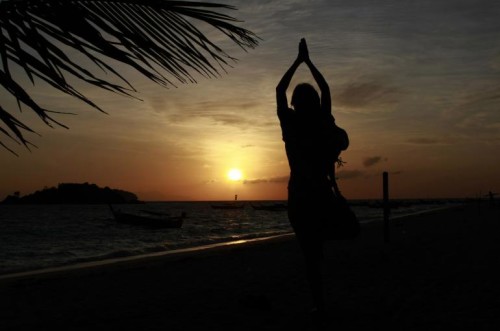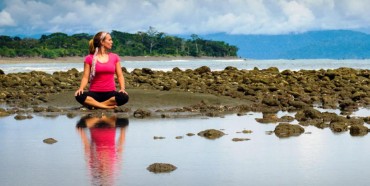
Wellness tourism is a growing sector within the travel industry. REUTERS/Arthur Jones Dionio
To celebrate her 40th birthday, Ann Abraham, an information technology consultant in Dallas, wanted to try something completely new. She had traveled with friends and family in the past, but she’d never taken a solo trip. And, to mark what was a milestone in her life, she wanted to discover something about herself.
“I was trying to find something completely out of the box for me,” says Abraham. “I wanted to explore a spiritual side, to become better at meditation.” Thailand sounded like an appealing destination, so she started researching tours online. And while she was excited to go somewhere by herself, she wanted some guidance and structure, too. “I could get lost in a grocery store,” she says.
Abraham ended up traveling to Chiang Mai, Koh Klang and Koh Lanta last November, on a two-week small group tour arranged by Pravassa Wellness Travel , a New York City based tour company that creates “balanced vacations” offering “a unique travel experience to renew self-care.”
The experience, says Abraham, was life-changing. Each day iran Thailand started with a yoga session, followed by some kind of cultural activity designed to get the travelers interacting with locals and seeing the country from a unique perspective. Abraham and her fellow tour members met with Buddhist monks and arranged to bring them food, spent a day at an elephant park taking care of elephants that had been abused, tasted worms in a local market and attended a celebration of Thailand’s famed Loi Krathong lantern festival, where Abraham released her own candle-lit paper lantern into the sky along with thousands of others.
“On a normal trip, you might go to the city, visit some tourist attractions. This trip involved actually spending time with people there,” says Abraham.
Abraham’s trip can be categorized into a newly flourishing sector of the travel industry known as “wellness travel.” According to research firm SRI International, wellness tourism is a $494 billion industry that has grown 12.7 percent since 2012.
“Back in the day, wellness travel was focused on the notion of spas,” says Anne Banas, executive editor of SmarterTravel. “But now, it’s really expanded into this area of experiential travel, with a combination of well-being, fitness and soulful, spiritual experiences as well as working on the mind-body connection. Connecting to local community is also a big part of it.”
Modern travelers “are looking for unique experiences,” says Sean Murphy of Jetsetter.com. “They want the power of discovery.”
Such wellness vacations align with that notion. Wellness travel includes the classic yoga retreats and spa experiences, of course, but also extreme fitness boot camps, agro-tourism and farm stays, hot springs and thermal bath trips, cycling vacations and more.
Linden Schaffer, the owner of Pravassa, says that when she launched her company almost six years ago, the term “wellness travel” didn’t even really exist. She wanted to offer vacations helping people “restore your best self.” To that end, all the trips arranged by Pravassa include some kind of stress reduction activity such as yoga or meditation, interaction with local culture, physical activity, food education and what Schaffer calls spiritual connection. But most people assumed such trips meant going to an ashram or eating an all-vegetarian diet. “We ended up calling it healthy travel,” says Schaffer, who arranges 25 to 30 trips a year in destinations from Argentina to Vietnam.
Today, the term “wellness travel” has exploded and more players want a piece of the wellness tourism action. The hotel industry has picked up on the fact that travelers are looking for a holistic experience when they vacation. Major resort and hotel brands such as Marriott, Hilton and Shangri-la are adding services to their properties that include everything from yoga classes and in-room fitness videos to locally sourced food offerings and expanded gyms and spas. Both Starwood Hotels and InterContinental Hotels Group have launched their own dedicated wellness brands of hotels.
“The travel industry is realizing that people have difficulty relaxing and unplugging,” says Banas. “So they’re building this stuff in. In 2014, a bunch of hotel chains rolled out new wellness programs, like offering fitness classes on the hotel rooftop. And IHG is rolling out a new hotel chain called Even, completely dedicated to wellness. When you see it at the major chain level, that’s when you know the trend has hit the mainstream.”
In addition to a proliferation of resorts and retreats dedicated to helping you unwind through experiences such as hiking, cooking classes and all sorts of fitness options, the trend has even spawned the rise of “wellness travel agents” dedicated to arranging trips for busy individuals who want their own custom-designed experience.
And while destinations such as India have been traditionally associated with wellness travel, sub-Saharan Africa is the world’s fastest growing region for such trips, reports Skift . Tourists spent $3.2 billion on wellness experiences in the region there in 2013, up 57 percent from the previous year.
But the U.S. has a firm hold on the wellness market, says Susie Ellis, chairman of the Global Spa and Wellness Summit. “Europe, Asia, the U.S. and Canada are all fairly close in terms of how mature their wellness markets are,” Ellis told Skift . “The most important reason why tourists are looking for wellness experiences is prevention, and we’re seeing more destinations make a conscious effort to offer these experiences that focus on prevention.”
Abraham, who travelled to Thailand with Pravassa, says she would love to take another trip like that. “It was fascinating to see what kind of person I could be without someone else’s restrictions and expectations around me,” she says. “It was kind of a journey of self discovery for me.”
source: http://www.ibtimes.com / International Business Times / Home> Media & Culture> Travel / by Ismat Sara Mangla / January 30th, 2015





